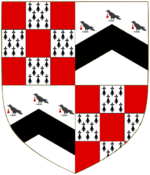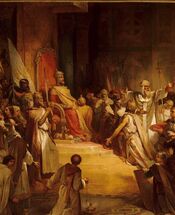House of Thomaz-Rocha
 | |
| Country | |
|---|---|
| Parent house | Mac Thomaz (agnatic) de la Roche (cognatic) |
| Titles | Archduke of Karnia Duke of Mainarque Duke of Montfort Prince of Ruthenia Count of Burnay Count Vincefort Count of Rochen |
| Founder | Tomaidh Mòr (16th century) Pons de la Roche (12th century) |
| Current head | HIRH Archduke Ari of Karnia |
| Founding | 12th century |
| Cadet branches | House of Götzö-Thomaz-Rocha |
| Ethnicity | French, Scottish |
The House of Thomaz-Rocha (Portuguese: Casa de Thomaz-Rocha, French: Maison de Thomaz et de la Roche) is a noble family, macronationally connected to the Duchy of Athens and other crusader states, and micronationally connected to Karnia-Ruthenia and the Occidian Empire. The Thomaz branch have their origin in Scotland, while the de la Roche are a French family from Franche-Comtés.
Oscar I, an agnate of this family from the Götzö-Thomaz-Rocha branch, became a well-known micronationalist and raise this family to proeminence again within micronational circles, also founding the ruling branch of Karno-Ruthenian and Occidian monarchies.
History

Mac Thomaz
The Scottish family was first mentioned in a roll of the clans, in the Acts of Parliament of 1587 and 1595[1] and seems to have their origin in Badenoch, Scotland. It is also known that in the 17th century, during the Scottish Civil War, the family supported Charles I. After the Restoration of 1660, the family was fined heavily by Parliament on attempt to recover some lands, whicd led the family to a serious financial problem. They were forced to sell the lands and moved south to the Tay Valley.
Now Roman Catholics, the family left for the continent during the events of the English Reformation and to America during the first half of 19th century. First in United States, they left for unknown reasons to Brazil, where their descendants live until today.
De la Roche

The first mention of the family dates from 12th century, by the event of the Fourth Crusade. The chronicler Alberic of Trois-Fontaines writes that Othon, Monssu and an unnamed son were the children of Pons of La Roche, from the Duchy of Burgundy The most famous of the children of Pons de la Roche, Othon, confirmed his forefathers' donations to the Charlieu Abbey in 1195. He was with the Fourth Crusade on its arrival before the walls of Constantinople in 1203. At that time, he was a member of the "sixth division" of the crusading army, which "was formed by the people of Burgundy", according to the chronicler Geoffrey of Villehardouin. The crusaders captured Constantinople on 12 April 1204. They started the conquest of the Byzantine Empire under the command of Baldwin IX of Flanders who was elected the first Latin Emperor of Constantinople on 9 May of that year.
The distribution of the conquered lands gave rise to conflicts among the commanders of the crusaders, but Othon, as stated by Villehardouin, was one of the four "chief counsellors" of Boniface of Montferrat during the discussions. An agreement on the distribution of the Byzantine Empire was reached in October 1204 and to Othon de la Roche, was given Athens. It is possible that Othon also received Thebes from Boniface, although Jean Longnon has argued that Boniface granted Thebes to Albertino after the conquest.

Monssu de la Roche, the youngest son of Pons de la Roche, joined the Crusader efforts, and some years later, when the Popes called the knights of Europe to join the effort to destroy the Muslim states of the Iberian Peninsula, he fought along the Portuguese forces. After the so-called Battle of Alarcos, French, Navarrese, Castilian, Portuguese and Aragonese armies were united against the Muslim forces in the massive Battle of Las Navas de Tolosa. Monssu survived the battle and established himself in Portugal, where his descendants lived until the invasion of Portugal by the forces of Napoleón Bonaparte. They fled to Brazil where they live until today.
Union of the families
Descendants of the two families finally met at 1938, with the wedding of Anton Thomaz and Judith Rocha - heirs of the Mac Thomaz and the De la Roche, respectively. They are the grandparents of Oscar I, now known as Archduke Anton and Archduchess Judith. Among their descendants, is Ari, first King of Ruthenia and current head of the house, Oscar I, Emperor of Karnia-Ruthenia and of Occidia and Guilherme Ítalo, King of Taslavia.
Through the history of the Karno-Ruthenian Monarchy, the family hold the now extinguished titles of Count Vincefort, Count of Rochen, Duke of Mainarque, Prince of Mainarque, Duke of Montfort and Prince of Montfort. Currently, they only have the titles prescribed by the House Law of the Karno-Ruthenian Imperial Family, that merged their claims to the House of Goëtzën.
See also
References
- ↑ Way, George and Squire, Romily. Collins Scottish Clan & Family Encyclopedia